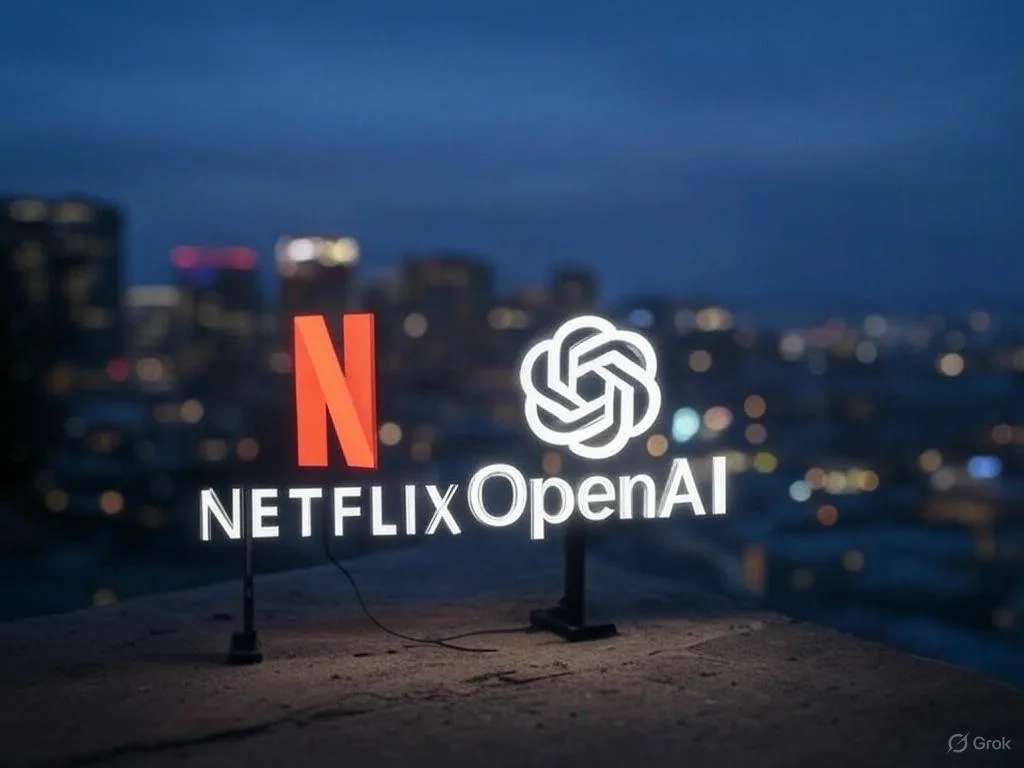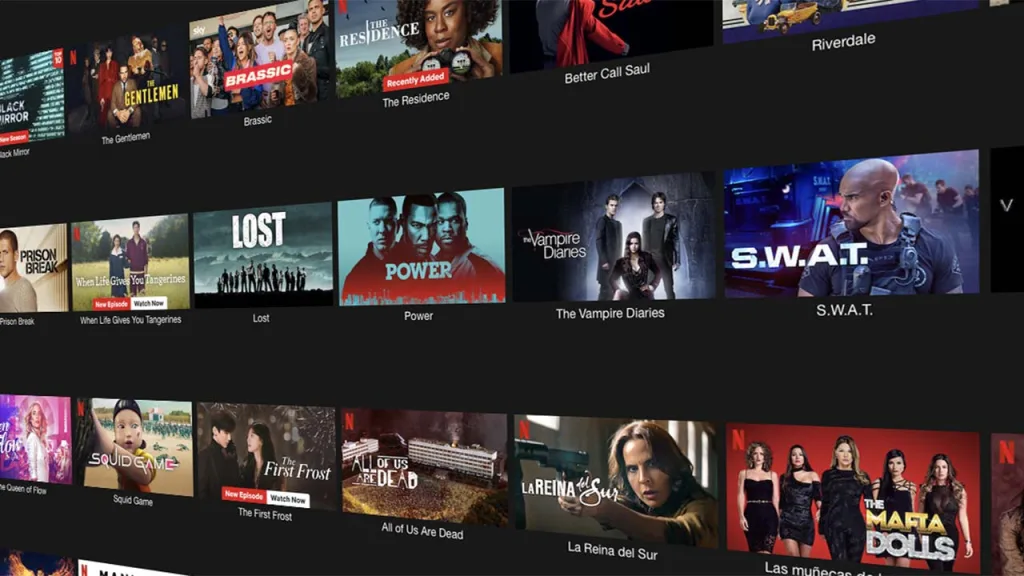Netflix AI Search: Are you tired of endlessly scrolling through Netflix, unable to find something that matches your mood? That frustrating experience might soon be a thing of the past. In a groundbreaking announcement that has sent ripples through the streaming world, Netflix has unveiled its new AI search feature powered by OpenAI technology. This innovative tool promises to transform how we discover content by understanding not just what we say, but what we actually mean when searching for something to watch.
Table of Contents
How Netflix OpenAI Search Understands Your Viewing Preferences
The Netflix AI search represents a fundamental shift in how we interact with streaming platforms. Instead of relying on rigid categories or keyword matching, this new feature allows you to search for content in a way that feels natural and conversational. Imagine asking Netflix for “something funny that will make me feel nostalgic” or “a thriller that isn’t too scary but has a good twist” – and actually getting relevant results.
“We’re always looking for ways to improve the Netflix experience and help our members find titles they’ll love,” said MoMo Zhou, a Netflix spokesperson. “We’re currently testing a new search experience powered by AI that allows members to find titles using conversational language.”
The technology behind Netflix OpenAI search represents years of machine learning development and marks a significant evolution from the company’s traditional recommendation system. By leveraging OpenAI’s advanced natural language processing capabilities, Netflix can now interpret the intent and emotion behind your searches, not just the literal words you type.

Inside Netflix AI Feature: A Revolutionary Approach to Finding Content
This Netflix AI feature is currently being tested in select markets before a global rollout. The initial beta testing is taking place in Australia and New Zealand, specifically for iOS users, with plans to expand to the U.S. market soon. According to Netflix, this AI feature will help surface lesser-known titles to wider audiences, addressing a significant challenge for the platform.
During a recent earnings call, Netflix CEO Greg Peters highlighted the importance of this development: “Only about 1% of our titles account for a significant portion of our viewing. By improving discovery, we can provide more value to our members and reach larger audiences for our titles.”
The Netflix AI search transforms how users discover content on the platform in several key ways:
- Natural language understanding: You can describe what you want to watch in everyday language
- Emotional context recognition: The system understands moods and feelings, not just genres
- Personalized interpretation: Searches are processed in the context of your viewing history
- Conversational interaction: The search experience feels more like talking to a knowledgeable friend
This approach aims to solve one of streaming’s biggest paradoxes – having thousands of titles available but struggling to find something you actually want to watch.
Netflix Mood-Based Search: Finding Shows That Match How You Feel
The Netflix mood-based search allows you to find content that matches how you feel, rather than forcing you to browse by rigid categories. This represents a significant shift from category-based to emotional discovery.
“Sometimes you don’t know exactly what you want to watch, but you know how you want to feel,” explains a Netflix product developer. “Our new search understands that nuance.”
Using Netflix mood-based search, viewers can ask for “something funny and nostalgic” or “an uplifting movie after a long day.” The AI interprets these emotional cues and delivers recommendations that align with your current state of mind.
This emotional intelligence sets the feature apart from traditional search functions. Netflix viewing moods can range from “something light and funny” to “thought-provoking drama,” and the AI is designed to understand this spectrum through sophisticated natural language processing.

Why AI Search Netflix Technology is Changing How We Watch
The AI search Netflix has implemented works by understanding conversational queries in a way that previous search functions couldn’t. This represents a fundamental shift in how we interact with entertainment platforms.
“The traditional way of finding content – scrolling through categories or typing exact titles – doesn’t reflect how people naturally think about entertainment,” notes a streaming industry analyst. “We think about movies and shows in terms of moods, themes, and feelings. This new search bridges that gap.”
How does the Netflix AI search is testing differ from traditional search functions? Traditional search requires you to know what you’re looking for – a specific title, actor, or genre. The new AI-powered search allows you to describe what you want in natural language, even if you don’t have a specific show in mind.
This Netflix search upgrade represents the first major change to the interface in a decade. It’s part of a broader redesign effort that includes updating how show titles and descriptions are displayed, all aimed at improving content discovery.
Netflix Conversational Search: Talk to Your TV Like a Friend
With Netflix conversational search, you can describe what you want rather than searching by title or scrolling through endless categories. This creates a more intuitive and human-like interaction with the platform.
“It’s like having a conversation with someone who knows everything about movies and shows,” says a beta tester from Australia. “I can say something like ‘I want something like Stranger Things but more scary’ and it actually understands what I mean.”
The Netflix conversational search feels more like talking to a knowledgeable friend who understands your tastes and preferences. It can interpret complex queries about themes, emotions, and story elements that would confuse traditional search algorithms.
This approach is particularly valuable for discovering content outside your usual viewing patterns. By understanding the essence of what you’re looking for rather than matching specific keywords, the system can recommend shows and movies you might never have found otherwise.

How Netflix AI Recommendations Have Evolved Over Time
The Netflix AI recommendations system has evolved significantly since its early days. When Netflix first launched its streaming service, recommendations were primarily based on user ratings and basic collaborative filtering – essentially, “people who liked this also liked that.”
In 2006, Netflix launched the famous Netflix Prize, a competition offering $1 million to anyone who could improve their recommendation algorithm by 10%. This initiative sparked significant advancements in recommendation systems and demonstrated Netflix’s commitment to using data science to improve user experience.
Over the years, Netflix has continuously refined its approach, incorporating viewing history, time of day, devices used, and even how users browse the platform. The new Netflix AI recommendations now consider your mood rather than just viewing history, representing the next evolutionary step in this journey.
“Our recommendation systems have been using AI for over two decades,” notes a Netflix engineering blog post. “This new search feature builds on that foundation while taking a completely new approach to understanding user intent.”
Netflix Content Discovery AI: Beyond Traditional Recommendations
The Netflix content discovery AI aims to surface titles beyond the top 1% most watched, addressing what the company calls the “discovery gap.” This is crucial for both users and content creators – viewers get more variety, and more Netflix productions get the audience they deserve.
How Netflix content discovery AI works to understand your unique preferences goes beyond simple matching algorithms. It analyzes patterns in viewing behavior, contextual factors, and now, with the OpenAI integration, the emotional and thematic elements you express in your searches.
“Discovery is a critical part of our business,” Peters explained during the earnings call. “When members can easily find great stories that they love, they watch more, they enjoy Netflix more, and they retain better.”
This Netflix user experience improvement addresses the challenge of content overload that many subscribers face. With thousands of titles available, the paradox of choice can actually make decision-making harder. By understanding what you’re really looking for, the AI helps cut through the noise.
The Netflix OpenAI Partnership: What It Means for Streaming
The Netflix OpenAI partnership demonstrates the streaming giant’s commitment to innovation in an increasingly competitive market. As other services like Disney+, Amazon Prime Video, and HBO Max continue to expand their content libraries, the user experience becomes a key differentiator.
Through the Netflix OpenAI partnership, the company hopes to enhance user satisfaction and engagement. This collaboration brings together Netflix’s vast understanding of viewer preferences with OpenAI’s cutting-edge language processing capabilities.
“This is just the beginning of how generative AI can enhance the entertainment experience,” suggests a tech industry analyst. “We could eventually see this technology applied to content creation, personalized trailers, or even interactive storytelling.”
The partnership also signals Netflix’s strategy of focusing on technology as a competitive advantage. While other services compete primarily on content, Netflix is investing in making that content more accessible and enjoyable through technological innovation.

Current Netflix Beta Test Search Rollout in Australia and New Zealand
The Netflix beta test search is currently available to iOS users in Australia and New Zealand, with plans to expand to the U.S. market in the coming months. This limited rollout allows the company to gather user feedback and refine the feature before a global launch.
“We’re in a ‘learn and listen’ phase,” explains Zhou. “We want to understand how members interact with this new search experience before making broader decisions.”
Feedback from the Netflix beta test search will inform the global rollout strategy, helping the company identify any issues or opportunities for improvement. Early reports from testers have been largely positive, with many highlighting the intuitive nature of the search experience.
The testing phase also includes gathering data on how different demographic groups interact with the feature, ensuring it works well for Netflix’s diverse global audience. This careful approach reflects the importance Netflix places on getting the user experience right.
Benefits of Netflix Personalized Search for Different Viewers
Netflix personalized search adapts to individual viewing preferences over time, creating a unique experience for each subscriber. This personalization goes beyond simply recommending similar content – it understands the context of your search based on your viewing history.
For example, if two different users search for “funny movies,” they might receive completely different recommendations based on their previous viewing patterns and preferences. One might see quirky indie comedies, while another might see mainstream blockbusters.
This level of personalization is particularly valuable for:
- Families sharing accounts: The system can distinguish between different viewers
- Viewers with eclectic tastes: The AI understands your various moods and interests
- Content explorers: Those looking to discover new genres and styles
- Decisive viewers: People who know what they want but not specific titles
The Netflix personalized search experience continues to learn and adapt with each interaction, becoming more accurate and helpful over time.
Understanding Netflix Viewing Moods and How AI Interprets Them
The AI understands Netflix viewing moods through natural language processing and contextual analysis. When you enter a search query like “something relaxing after a stressful day,” the system breaks this down into emotional components and contextual cues.
Netflix viewing moods can range from specific (“edge-of-your-seat thrillers”) to abstract (“something that will make me think”). The AI is trained to recognize these patterns and match them to content attributes that might not be captured in traditional genre classifications.
“We’ve developed a sophisticated understanding of content that goes beyond basic categories,” explains a Netflix data scientist. “We analyze hundreds of attributes for each title – themes, tone, pace, character types – and match these to the emotional and thematic elements in user searches.”
This emotional intelligence represents a significant advancement in how streaming services understand and respond to user needs, creating a more intuitive and satisfying discovery experience.
Major Netflix User Experience Improvement After a Decade
This Netflix user experience improvement comes after years of research and development, marking the first major structural change to the platform’s interface in over a decade. The company is not only enhancing search but also redesigning how show titles and descriptions are displayed.
“We’re making the biggest structural change to the Netflix homepage in more than 10 years,” Peters noted during the earnings call. This comprehensive approach demonstrates Netflix’s commitment to improving the overall user experience, not just adding new features.
The timing of this update coincides with an increasingly competitive streaming landscape, where user experience can be as important as content in retaining subscribers. By making it easier to find relevant content, Netflix aims to increase engagement and reduce churn.
Industry experts see this as a strategic move to maintain Netflix’s position as a streaming leader. “In the early days, just having a large content library was enough,” notes a media analyst. “Now, with so many options available to consumers, how easily they can find what they want to watch becomes crucial.”
What This Means for the Future of Streaming
The Netflix AI technology now powers multiple aspects of the viewing experience, from recommendations to search, and potentially much more in the future. This integration of advanced AI throughout the platform signals a new direction for streaming services.
This Netflix streaming innovation could set new standards for the industry, potentially influencing how other services approach content discovery. As viewers become accustomed to more intuitive search experiences, expectations across all platforms may shift.
Looking ahead, we might see:
- Further integration of AI across the Netflix platform
- More personalized content creation based on viewer preferences
- Enhanced interactive features powered by natural language processing
- Expansion of mood-based discovery to other aspects of the service
“We’re just scratching the surface of what’s possible,” suggests a Netflix engineer. “As these technologies continue to evolve, so will the ways we interact with entertainment.”
For Netflix users, the message is clear: finding your next favorite show or movie is about to become much easier. No more endless scrolling or settling for “good enough” – the future of content discovery is conversational, emotional, and tailored specifically to you.
Are you ready to talk to Netflix about what you really want to watch?








